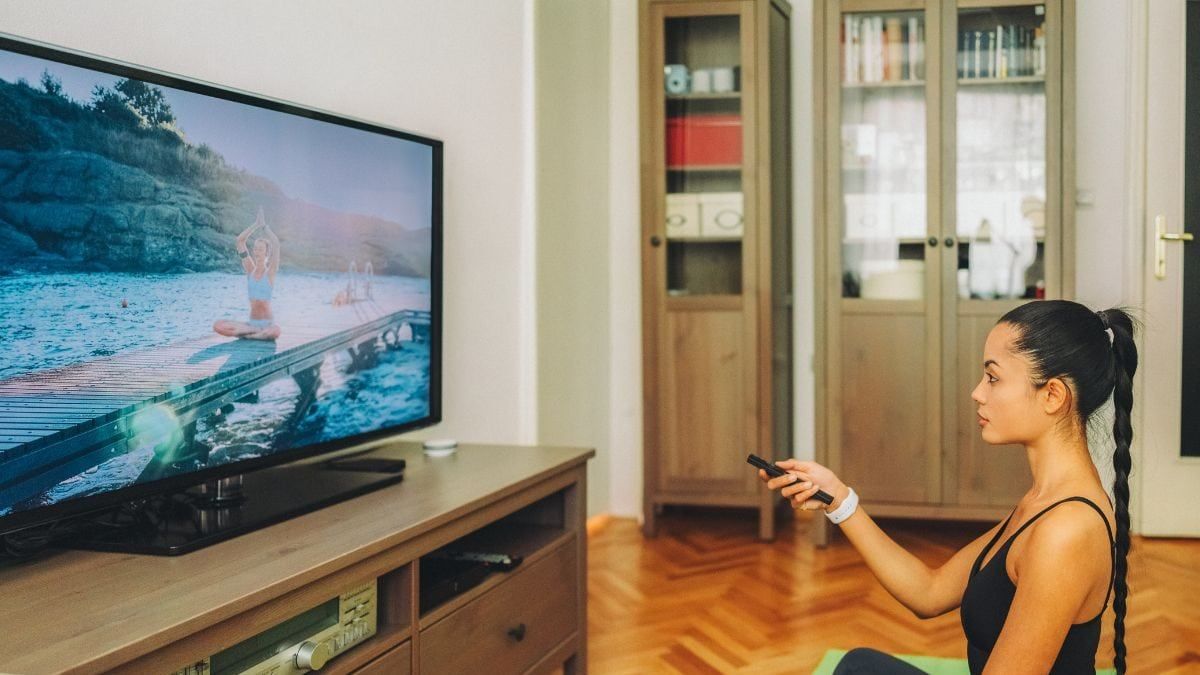Are you not a big fan of exercise but you manage to do it with the help of television? It has been found that watching television can distract us from doing exercises we don't like. Therefore, adding a distraction like television to exercise can encourage people, especially those who are not inclined towards physical activity, to do it.
Others argue, however, that TV causes us to focus in a scattered way, which prevents us from improving and reaping the full benefits of exercise. In addition, distraction and insufficient attention to the body can lead to injuries. Worse still, doing things without thinking keeps us stressed and can lead to anxiety.
NOW APPLY THIS TO YOGA
If this ambiguity exists even in the case of workouts, how much more so in the case of yoga, where presence in the body, mindfulness and coordination with breathing are essential requirements? “No, noooooooo!” answers an experienced yoga teacher when asked if it is possible to perform yoga postures while watching television. This is because one of the main differences between exercise and yoga practices is awareness, she explains. Promoting yoga in this way is, in her opinion, a “marketing trick”.
LET'S CHANGE THE LOGIC
How about turning the logic on its head? Instead of making yoga more enjoyable through television, one could make TV time more productive by using some yoga techniques that can be performed (and will yield results) while one remains “distracted.”
What are some of the purposes that yoga might serve and what practices should be used? Here are some suggestions:
Don't be a slacker
Watch the spectacle of sitting in Vajrasana: To count, the benefits are improved digestion, improved blood circulation in the lower abdomen, increased circulation in the upper body i.e. the lungs, heart and brain as blood flow is reduced to the lower body. The back remains effortlessly straight and provides a fixed base and a sense of harmony in the body.
How to do it: Sit on a sofa, armchair or bed (the cushion or mattress should not be too soft) and get on your knees, with your toes together pointing backwards. *Carefully lower your body to sit in the hollow formed by your heels. *Make sure your back is straight, your thighs and knees together and your shoulders relaxed. *Place your palms on your respective thighs, close to your knees. *Breathe normally and watch your TV programme.
Breathe!
Full Breathing: Any involvement leads to attachment and in turn to arousal. Exciting emotions make breathing rapid and irregular. Be aware of your breathing: is it shallow? Do you hold your breath at times? Correct yourself.
*Breathe deeply until your abdominal cavity is full. *Exhale completely. *Repeating this a few times will calm your breathing and, in turn, your mind. *Returning your attention periodically from the TV to your body and breathing will help you take control of your mind and keep your emotions under control.
Conscious relaxation: Also, observe your body to see if excitement has caused tension in the muscles of the abdomen, jaw, face, forehead and shoulders. * Correct your posture. * Remain relaxed, in a state of balance.
Take breaks to rest your eyes
Hollowing of the eyes: According to yoga guru Dr. Hansaji Yogendra, 50 percent of our body's energy is lost through the eyes. *To relieve eye strain, gently rub your palms together to generate heat and cup your palms around your eyes. *Remain in this position for five seconds. *You can also gently press the “rim of the cup” and then release. *Press and release three times. This practice, usually done at the end of Trataka and Pranayama sessions, relaxes and energizes the eyes.
Change range: Every now and then, shift your range of vision and look at something close. *Move your gaze without moving your neck: from the tip of your nose to your right shoulder, then back to the center and to the left, and back again. Similarly, move your gaze slowly up and then down. Cover your eyes with one hand to warm them.
An opportunity to get your joints moving
Relaxation exercises in Dandasana (Staff Pose): *Relax your neck with slow movements from top to bottom and from left to right. *Rotate your shoulders clockwise and counterclockwise. *Make fists with your hands, release and repeat. *Rotate your wrists clockwise and counterclockwise. *Bend your arms at the elbows and straighten them again. *Flex your toes inward and outward. *Flex and rotate your ankle joints.
The butterfly pose: This practice loosens and strengthens the hip and pelvic joints.
How to do it: *From the initial Sukhasana (Easy Pose) position, uncross your feet and bring the soles, toes and heels together. *The knees point outwards and the legs rest flat on the floor. *Hold the feet with both hands to keep them fixed on the floor and move the legs up and down as the butterfly flaps its wings. Make sure that the back remains straight. *Do this for as long as possible, do not overdo it.
How to take advantage of the commercial break to expand
Parvatasana (Seated Mountain Pose) with the TV volume down: This Asana helps to improve circulation, stretch the abdominal muscles, reduce constipation and improve digestion.
How to do it: Sit in a chair with your back straight, hands at your sides, feet flat on a mat on the floor, and look straight ahead. *Inhaling for 3 seconds, stretch both arms up from your sides and bring them together above your head. *Stretch your joined palms upward; make sure your upper arms touch your ears and your back remains straight. *Hold this stretched position for six seconds. *Exhale for three seconds, turn your palms outward, and lower your arms. *This completes one round. Do 4-5 rounds.
The author is a journalist, cancer survivor and certified yoga teacher. She can be contacted at [email protected].












